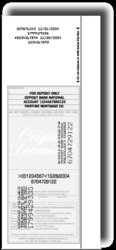Haven't I-RD Seen This?

In today's sports action, we learned that Bank A has been returning Bank B's re-presented IRDs (image replacement documents) as duplicates. Bank B asked us to referee a bit, since both are customers.
It's quite common for a collecting bank to re-present a returned item to the paying bank to "try again." This second presentment looks just like the first one, but with additional prior return data like return reasons and endorsements. If you ignore the additional data, it does in fact look like a duplicate transaction. True duplicate transactions are a bad thing, but can happen with all the conversion that goes on between paper, image, IRD, and ACH. Duplicates must be stopped, but separating potential duplicates from real ones can be tricky business.
Exactly where this prior return data shows up depends on when the item was truncated (converted from paper to electronic or image). In this case, a paper check was converted to an electronic image (X9) for collection and return, and then converted to an IRD for re-presentment. Because of the early conversion, there were no return reason stamps on the face of the image. And, since it was a forward presentment IRD, there was no Region 7F to house the return reason on the front. From looking at the IRD, the only clue that it was once returned is on the back: the return reason appearing in the (small and sideways) subsequent endorsements, after "RR". That's how the standards go.
Bank A had kicked in some new aggressive duplicate detection rules that flagged re-presents as suspects. It's tough enough that operators had to review the images to check for returns, but they were only looking at the front image, and missing the fact that all these transactions were legitimate.
One option is to put the return reason on the face, but that would be bending the standards. That's because, in theory, things like this should never happen. And so it goes when standards are involved: in theory, there is no difference between theory and practice, but, in practice there often is.